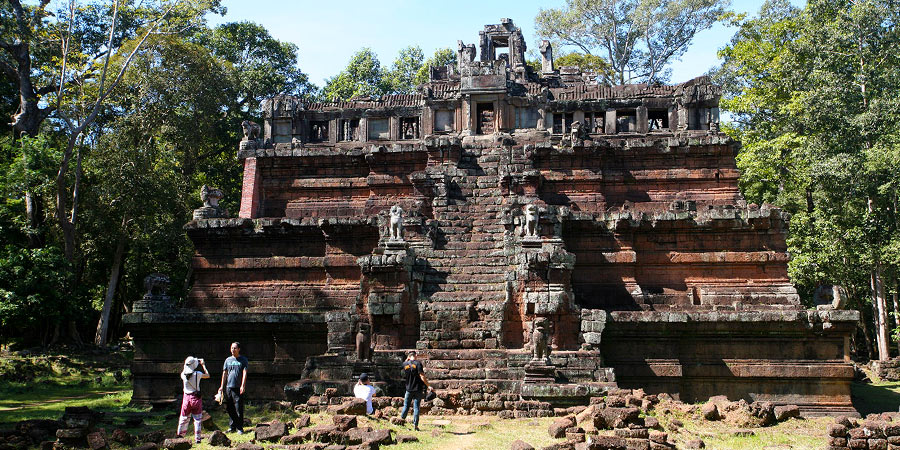Phimeanakas Temple
The great Angkor Archaeological Park in Cambodia is home to some of the most renowned Hindu temples that were constructed during the times of the Angkor Empire. While thousands of visitors make their way to the South-East Asian country to behold the breathtaking Khmer architecture of the main Angkor Wat temple complexes, there are many other Angkor temples that deserve your attention as well.One such temple is the Phimeanakas Temple. Phimeanakas translates to “celestial temple” in English. We will take a closer look at the temple, its history, its architecture and how you can visit it when you are in Cambodia.
Facts of Phimeanakas Temple
1. When was the temple built and who built it?
The Phimeanakas Temple dates back to the late 10th century when its construction was commissioned by King Rajendravarman, who ruled the Angkor Empire from 941 – 968.The construction of the temple, however, was not completed during King Rajendravarman’s reign. It was completed under the reign of King Suryavarman I, who was known for practicing Mahayana Buddhism and his tolerance towards practicing Hindus, as Hinduism was Cambodia’s predominant religion during the days of his rule.

Three-tiered Pyramid Structure
|
2. Is the temple a Buddhist temple or a Hindu temple?
Even though the construction of Phimeanakas was completed under the reign of a ruler who practiced Mahayana Buddhism, it was built as a Hindu temple.However, it is unclear which Hindu deity the temple was dedicated to. Most Hindu temples in the Angkor Archaeological Park were built in dedication to one of Hinduism’s most important deities, Lord Shiva.
3. How big is the Phimeanakas Temple?
While the Angkor Archaeological Park is home to some mammoth temples, the Phimeanakas Temple is not one of them. Among the popular temples in Angkor, it is one of the smaller ones, but it still goes up to 40 meters (131 ft.) in height.4. What material was used to build the temple?
The temple was built predominantly using laterite. While ancient Khmer architecture was known mostly for its prowess at using sandstone to create spectacular buildings and monuments, the use of sandstone still wasn’t prevalent at the time of Phimeanakas’ construction.Architectural Highlights
As Phimeanakas is a relatively small temple in the Angkor Archaeological Park, it has fewer architectural highlights than some of the bigger temples in the park. However, there are still some highlights that make the temple worthy of a visit.It’s three-tiered pyramid immediately catching the eye and its location in the midst of the dense Cambodian jungle exudes a really haunting feeling. Visitors should visit the top tier for some amazing views of the surroundings, which also present spectacular views of the Baphuon Temple, a nearby temple that was constructed in the 11th century.
Stories about the Temple
There is a legend that tells quite a fascinating story about the Phimeanakas Temple.It is said that once, the temple featured a golden tower on its top, where a Naga (nine-headed serpent spirit) used to live. Legend has it that the spirit used to take the form of a princess every night and the King would lie with the princess every night after climbing to the top of the tower.
If the princess did not make an appearance, then the King would consider his days numbered.
Best Time to Visit
The view the ruins of the temple in all its glory, tourists are recommended to visit during the hours of mid-day.In terms of season, the summer months are ideal for visiting the temple. As the winter months witness peak tourist footfall, with the Angkor Archaeological Park featuring heavily on every traveler’s itineraries, you may encounter huge crowds if you travel in winter.
Summers in Cambodia may be very hot and extremely humid, but they offer tourists the ideal settings to explore the Angkor temples peacefully. Also, taxis and tuk-tuks won’t overcharge you during summers as they are considered off-season.
Spare at least an hour of your time for the Phimeanakas Temple on your visit to Angkor. It’s an experience that will stay with you for your whole life.
Location & Transport
To visit the Phimeanakas Temple today, travelers need to reach the ruins of the ancient city of Angkor Thom which was established as the last seat of power during the glory days of the Khmer Empire.Angkor Thom is just 11 km (7 mi) away from the nearest city, Siem Reap, and you can easily get taxis and tuk-tuks to the site of the temple. You can book taxis and tuk-tuks for $15 - $22 to give you a tour of the major temples in the Angkor Archaeological Park.
If you plan to go solo by renting a motorbike or bicycle, then you can take the following route to reach the temple:
• Head out from Siem Reap by taking the Sivatha Road
• Reach the Angkor Wat moat and turn left, which will lead you towards the temple of Bayon
• From the Terrace of the Leper King, go for another 10 minutes to reach the Elephant Terrace, from where you can easily spot the Phimeanakas Temple
Tickets & Entry Fees
Tourists need to purchase entry tickets to visit the temples housed in the Angkor Archaeological Park. At present, there are three tickets available that allow tourists to visit the park on the basis of the number of visiting days.
|
Ticket of Angkor Archaeological Park |
Prices |
|
1-day ticket |
$37 |
|
3-day ticket |
$62 |
|
7-day ticket |
$72 |

